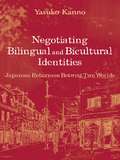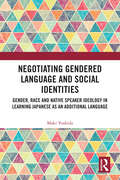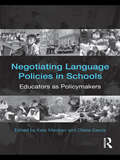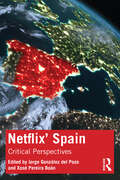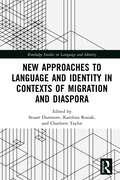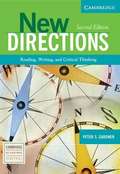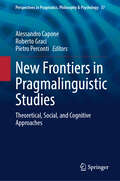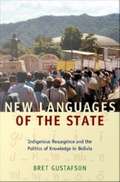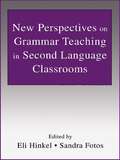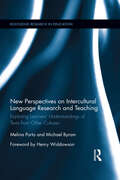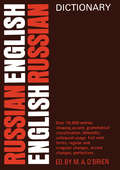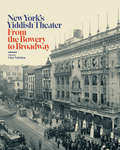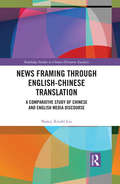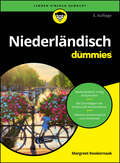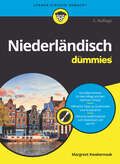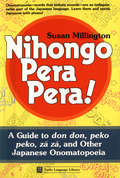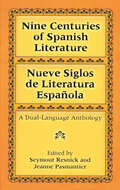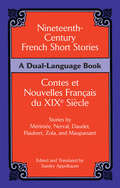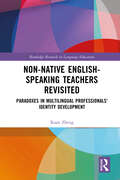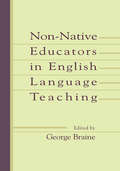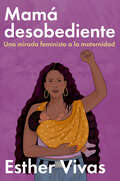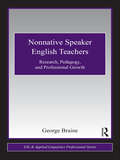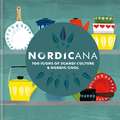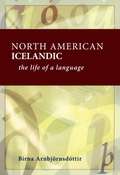- Table View
- List View
Negotiating Bilingual and Bicultural Identities: Japanese Returnees Betwixt Two Worlds
by Yasuko KannoThis book examines the changing linguistic and cultural identities of bilingual students through the narratives of four Japanese returnees (kikokushijo) as they spent their adolescent years in North America and then returned to Japan to attend university. As adolescents, these students were polarized toward one language and culture over the other, but through a period of difficult readjustment in Japan they became increasingly more sophisticated in negotiating their identities and more appreciative of their hybrid selves. Kanno analyzes how educational institutions both in their host and home countries, societal recognition or devaluation of bilingualism, and the students' own maturation contributed to shaping and transforming their identities over time. Using narrative inquiry and communities of practice as a theoretical framework, she argues that it is possible for bilingual individuals to learn to strike a balance between two languages and cultures. Negotiating Bilingual and Bicultural Identities: Japanese Returnees Betwixt Two Worlds: *is a longitudinal study of bilingual and bicultural identities--unlike most studies of bilingual learners, this book follows the same bilingual youths from adolescence to young adulthood; *documents student perspectives--redressing the neglect of student voice in much educational research, and offering educators an understanding of what the experience of learning English and becoming bilingual and bicultural looks like from the students' point of view; and *contributes to the study of language, culture, and identity by demonstrating that for bilingual individuals, identity is not a simple choice of one language and culture but an ongoing balancing act of multiple languages and cultures. This book will interest researchers, educators, and graduate students who are concerned with the education and personal growth of bilingual learners, and will be useful as text for courses in ESL/bilingual education, TESOL, applied linguistics, and multicultural education.
Negotiating Gendered Language and Social Identities: Gender, Race and Native Speaker Ideology in Learning Japanese as an Additional Language
by Maki YoshidaThis book explores gendered language and gender identities negotiated by seven tertiary students of Japanese as an additional language (JAL) in Australia. It demonstrates that while participants are familiar with gendered Japanese as linguistic resources, their self- positioned and ascribed ‘learnersness’, ‘nonnative-speakerness’ and ‘non- Japaneseness’ both inside and outside classroom contexts greatly impact the targeted negotiations. It argues that these ascribed social identities encourage participants to adopt ‘correct’ (gendered) Japanese; however, what exactly this ‘correctness’ means differs for each JAL participant, depending on their other reflective and perceived social identities—such as gender, age, class, race and English ‘native- speakerness’.This book draws on the conclusions on the implications of discourses and practices concerning native- speaker status, gender and race in Japanese language education. While the initial focus is on gendered Japanese and gender identity, this book subsequently expands that the participants’ negotiation of gendered Japanese and gender identity is complicatedly intertwined with negotiations of other social identities such as native- speaker status, race and age, with native-speaker status saliently affecting the way they position themselves and are positioned by their interlocutors. This book analyses the participants’ language resources, spoken and/ or written Japanese interactions and one-on-one and focus- group interviews and presents easily understood findings for readers who are interested in SLA, Japanese, language and/ or identity studies.This is the first book to holistically examine Australia- based tertiary students’ Japanese language learning experience and Japanese interactions with regards to (gendered) language, identities and discursive power relations in a global and multilingual world.
Negotiating Language Policies in Schools: Educators as Policymakers
by Kate MenkenEducators are at the epicenter of language policy in education. This book explores how they interpret, negotiate, resist, and (re)create language policies in classrooms. Bridging the divide between policy and practice by analyzing their interconnectedness, it examines the negotiation of language education policies in schools around the world, focusing on educators’ central role in this complex and dynamic process. Each chapter shares findings from research conducted in specific school districts, schools, or classrooms around the world and then details how educators negotiate policy in these local contexts. Discussion questions are included in each chapter. A highlighted section provides practical suggestions and guiding principles for teachers who are negotiating language policies in their own schools.
Netflix' Spain: Critical Perspectives
by Xosé Pereira Boán Jorge González del PozoThis edited collection analyzes the tensions, contradictions, contributions, and new horizons generated and/or imposed by Netflix within Spain’s audiovisual culture. This book provides invaluable insight into how Netflix—first in its role as distributor and then as content creator—has changed the audiovisual landscape in Spain. It discusses how Netflix challenges the traditional method of categorizing film and television output by nationality while also examining how Spain is presented to other countries through the Netflix catalog and questioning what its chosen output—light comedies, mystery/thrillers, narco-fiction, and crime—means for Spain’s national brand. With chapters addressing themes such as reproducibility, pan-Europeanism after Brexit, gender representation, identity, and globalization, this book explores how—under the influence of Netflix—Spain is transitioning from an importer of audiovisual content to a center of export. This book will appeal to students and scholars of Film and Media Studies, Hispanic and Iberian Studies, and Spanish with a specific interest in Spanish film, television, media, and culture, as well as global media industries.
New Approaches to Language and Identity in Contexts of Migration and Diaspora (Routledge Studies in Language and Identity)
by Charlotte Taylor Stuart Dunmore Karolina RosiakNew Approaches to Language and Identity in Contexts of Migration and Diaspora draws together expertise and contemporary research findings in respect of language and identity in migrant and diasporic contexts throughout the world.Over thirteen chapters, contributors examine the intersection between migration, language, and identity through analyses of migration discourses, language practices, and legal policy, as well as the ideologies embedded and revealed within them. A wide range of subject areas and interdisciplinary approaches are represented, with fifteen authors drawn from the fields of education, intercultural communication, linguistics, geography, migration studies, psychology, and sociology.This volume will primarily appeal to scholars and researchers in fields such as migration, intercultural communication, sociolinguistics, bilingualism, multilingualism, and heritage language learning.
New Directions: Reading, Writing, and Critical Thinking (Second Edition)
by Peter S. GardnerNew Directions, Second Edition is a thematic reading-writing book aimed at the most advanced ESL learners. The Student's Book prepares students for the rigors of college-level writing by having them read long, challenging, authentic readings as a precursor to writing. This emphasis on reading gives New Directions its distinctive character. Each of the five topic-based chapters contains three core readings and five additional readings. The readings come from a variety of genres and are accompanied by exercise material. The second edition represents a major revision. It contains two entirely new chapters and many new readings and activities in the other three. Another significant new feature is a section at the end of the first chapter that takes students through the writing process. Students work through it for their first writing assignment and return to this thorough treatment of the writing process for each subsequent major writing assignment.
New Frontiers in Pragmalinguistic Studies: Theoretical, Social, and Cognitive Approaches (Perspectives in Pragmatics, Philosophy & Psychology #37)
by Alessandro Capone Pietro Perconti Roberto GraciThis book contains a comprehensive view of pragmalinguistic studies and their recent ramifications, boasting some of the most advanced recent research in pragmatics. Organised into three sections—pragmalinguistics, social pragmatics, and cognitive-inferential pragmatics, respectively—the chapters enable an understanding of the possible applications of linguistic and philosophical theories in practical fields. Covering topics such as polysemy across languages and lexical externalism, the role of literal meaning in the construction of metaphorical meaning, the pragmatics of truth, the roles of reflexivity in meaning negotiation, argumentation and discourse, the pragmatics of taboo, linguistic and cognitive aspects of formation of implicates, and reflections on neuropragmatics and clinical pragmatics in Autism Spectrum Disorder and Schizophrenia—to name but a few exciting areas of exploration—this book is of interest to scholars and postgraduate students in the fields of semantics, pragmatics and philosophy of language, cognitive science, and other areas of linguistics.
New Languages of the State: Indigenous Resurgence and the Politics of Knowledge in Bolivia
by Bret GustafsonDuring the mid-1990s, a bilingual intercultural education initiative was launched to promote the introduction of indigenous languages alongside Spanish in public elementary schools in Bolivia's indigenous regions. Bret Gustafson spent fourteen years studying and working in southeastern Bolivia with the Guarani, who were at the vanguard of the movement for bilingual education. Drawing on his collaborative work with indigenous organizations and bilingual-education activists as well as more traditional ethnographic research, Gustafson traces two decades of indigenous resurgence and education politics in Bolivia, from the 1980s through the election of Evo Morales in 2005. Bilingual education was a component of education reform linked to foreign-aid development mandates, and foreign aid workers figure in New Languages of the State, as do teachers and their unions, transnational intellectual networks, and assertive indigenous political and intellectual movements across the Andes. Gustafson shows that bilingual education is an issue that extends far beyond the classroom. Public schools are at the center of a broader battle over territory, power, and knowledge as indigenous movements across Latin America actively defend their languages and knowledge systems. In attempting to decolonize nation-states, the indigenous movements are challenging deep-rooted colonial racism and neoliberal reforms intended to mold public education to serve the market. Meanwhile, market reformers nominally embrace cultural pluralism while implementing political and economic policies that exacerbate inequality. Juxtaposing Guarani life, language, and activism with intimate portraits of reform politics among academics, bureaucrats, and others in and beyond La Paz, Gustafson illuminates the issues, strategic dilemmas, and imperfect alliances behind bilingual intercultural education.
New Perspectives on Grammar Teaching in Second Language Classrooms
by Eli Hinkel Sandra FotosNew Perspectives on Grammar Teaching in Second Language Classrooms brings together various approaches to the contextualized teaching of grammar and communicative skills as integrated components of second language instruction. Its purpose is to show from both theoretical and practical perspectives that grammar teaching can be made productive and useful in ESL and EFL classrooms. In this text: *First-rate scholars approach the teaching of grammar from multiple complementary perspectives, providing an original, comprehensive treatment of the topic. *Discourse analysis and research data are used to address such pedagogical areas as grammatical and lexical development in speaking, listening, reading, and writing. *The communicative perspective on ESL and EFL instruction that is presented provides ways for learners to enhance their production skills, whereas the meaning-based grammar instruction can supplement and strengthen current methodology with a communicative focus. This volume is intended as a foundational text for second language grammar pedagogy courses at the advanced undergraduate and master's levels.
New Perspectives on Intercultural Language Research and Teaching: Exploring Learners’ Understandings of Texts from Other Cultures (Routledge Research in Education)
by Michael Byram Melina PortoIllustrated by an empirical study of English as a Foreign Language reading in Argentina, this book argues for a different approach to the theoretical rationales and methodological designs typically used to investigate cultural understanding in reading, in particular foreign language reading. It presents an alternative approach which is more authentic in its methods, more educational in its purposes, and more supportive of international understanding as an aim of language teaching in general and English language teaching in particular.
New Russian-English Dictionary (Dover Language Guides Russian)
by M. A. O’brienHandiest Russian dictionary in print, with surprising amount of information, including accent changes in declension and conjugation, irregular forms, special treatment of perfectives, etc. Used in scores of colleges. Over 70,000 entries.
New York’s Yiddish Theater: From the Bowery to Broadway
by Edna NahshonIn the early decades of the twentieth century, a vibrant theatrical culture took shape on New York City's Lower East Side. Original dramas, comedies, musicals, and vaudeville, along with sophisticated productions of Shakespeare, Ibsen, and Chekhov, were innovatively staged for crowds that rivaled the audiences on Broadway. Though these productions were in Yiddish and catered to Eastern European, Jewish audiences (the largest immigrant group in the city at the time), their artistic innovations, energetic style, and engagement with politics and the world around them came to influence all facets of the American stage. Vividly illustrated and with essays from leading historians and critics, this book recounts the heyday of "Yiddish Broadway" and its vital contribution to American Jewish life and crossover to the broader American culture. These performances grappled with Jewish nationalism, labor relations, women's rights, religious observance, acculturation, and assimilation. They reflected a range of genres, from tear-jerkers to experimental theater. The artists who came of age in this world include Stella Adler, Eddie Cantor, Jerry Lewis, Sophie Tucker, Mel Brooks, and Joan Rivers. The story of New York's Yiddish theater is a tale of creativity and legacy and of immigrants who, in the process of becoming Americans, had an enormous impact on the country's cultural and artistic development.
News Framing through English-Chinese Translation: A Comparative Study of Chinese and English Media Discourse (Routledge Studies in Chinese Discourse Analysis)
by Nancy Xiuzhi LiuNews Framing Through English-Chinese Translation provides a useful tool to depict how Chinese news translation can be examined in the era of globalization. The author has integrated framing theory in journalism studies with translation studies and developed a new theoretical model/framework named Transframing. This interdisciplinary model is pioneering and will make theoretical and conceptual contributions to translation studies. This book aims to reveal ideological, sociocultural and linguistic factors creating media discourse by examining Chinese media discourse, in comparison to its counterpart in English. Through the analysis of both quantitative and qualitative methods, it is concluded that the transframing model can be applied to interpreting, describing, explaining as well as predicting the practice of news translation.
Niederländisch für Dummies
by Margreet KwakernaakWenn es mehr als »Goededag« sein soll Niederländisch für Dummies bietet einen leichten Einstieg in die niederländische Sprache. Nach einer Einführung in die sprachlichen Besonderheiten, die Aussprache und die Grammatik wird es auch schon praktisch: Jedes Kapitel beschäftigt sich mit einer Alltagssituation. Sie lernen, wie Sie sich auf Niederländisch vorstellen, im Restaurant Essen bestellen oder ein Hotelzimmer reservieren. Ganz nebenbei erhalten Sie viele Informationen zu Alltag und Kultur in den Niederlanden. Am Ende jedes Kapitels gibt es eine kleine übung, mit der Sie Ihre neu erworbenen Sprachkenntnisse prüfen können. Sie erfahren Wie Sie Niederländisch richtig betonen Wie Sie sich beim Reisen auf Niederländisch zurechtfinden Was Sie in den Niederlanden nicht sagen sollten Wie Sie niederländische Redewendungen richtig benutzen
Niederländisch für Dummies (Für Dummies)
by Margreet Kwakernaak"Niederländisch für Dummies" bietet einen leichten Einstieg in die niederländische Sprache. Nach einer Einführung in die sprachlichen Besonderheiten, die Aussprache und die Grammatik wird es auch schon praktisch: Jedes Kapitel beschäftigt sich mit einer Alltagssituation. Sie lernen, wie Sie sich auf Niederländisch vorstellen, im Restaurant Essen bestellen oder ein Hotelzimmer reservieren. Ganz nebenbei erhalten Sie viele Informationen zu Alltag und Kultur in den Niederlanden. Am Ende jedes Kapitels gibt es eine kleine Übung, mit der Sie Ihre neu erworbenen Sprachkenntnisse prüfen können.
Nihongo Pera Pera !
by Susan MillingtonOnomatopoeia-words such as "glug glug," "pow," and "splash" in English- are an integral part of Japanese. Japanese people draw on a wealth of onomatopoeiato express subtle feelings, images, sounds, and actions. With this book you too can become pera pera - fluent- in Japanese, speaking with clarity and flair.Four hundred entries covering everything from food to weather provide clear definitions and helpful example sentences. With an overview of the use andhistory of onomatopoeic expressions, Nihongo Pera Pera! offers a systematic and entertaining approach to learning an essential part of Japanese. Add these expressions to your vocabulary and dramatically improve your ability to express yourself. A must for both serious and casual learners, Nihongo Pera Pera!is your key to fluency.
Nihongo Pera Pera !
by Susan MillingtonOnomatopoeia-words such as "glug glug," "pow," and "splash" in English- are an integral part of Japanese. Japanese people draw on a wealth of onomatopoeiato express subtle feelings, images, sounds, and actions. With this book you too can become pera pera - fluent- in Japanese, speaking with clarity and flair.Four hundred entries covering everything from food to weather provide clear definitions and helpful example sentences. With an overview of the use andhistory of onomatopoeic expressions, Nihongo Pera Pera! offers a systematic and entertaining approach to learning an essential part of Japanese. Add these expressions to your vocabulary and dramatically improve your ability to express yourself. A must for both serious and casual learners, Nihongo Pera Pera!is your key to fluency.
Nine Centuries of Spanish Literature (Dover Dual Language Spanish)
by Seymour Resnick Jeanne PasmantierThis rich sampling of Spanish poetry, prose, and drama includes more than seventy selections from the works of more than forty writers, from the anonymous author of the great medieval epic The Poem of the Cid to such 20th-century masters as Miguel de Unamuno. The original Spanish text of each work appears with an excellent English translation on the facing page.The anthology begins with carefully selected passages from such medieval classics as The Book of Good Love by the Archpriest of Hita and Spain's first great prose work, the stories of Count Lucanor by Juan Manuel. Works by writers of the Spanish Renaissance follow, among them poems by the Marqués de Santillana and excerpts from the great dialogue novel La Celestina by Fernando de Rojas.Spain's Golden age, ca. 1550-1650, an era which produced its great writers, is represented by the mystical poems of St. Teresa, passages from Cervantes' Don Quixote and scenes from Tirso de Molina's The Love-Rogue, the drama that introduced the character of Don Juan to the world, along with other well-known works of the period. A cavalcade of stirring poems, plays and prose selections represent Spain's rare literary achievements of the 18th, 19th and 20th centuries.The translations were chosen for their accuracy and fidelity to the originals. Among the translators are Lord Byron, Henry Wadsworth Longfellow, Edward FitzGerald and John Masefield. As a treasury of masterly writing, as a guide for the student who wants to improve his or her language skills and as a compact survey of Spanish literature, this excellent anthology will provide hours of pleasure and fruitful study.
Nineteenth-Century French Short Stories (Dover Dual Language French)
by Stanley AppelbaumCarefully chosen collection provides both the French original and new line-by-line English translations -- on facing pages -- of 6 great 19th-century French short stories. Merimée's Mateo Falcone, Sylvie by Nerval, Daudet's La mule du Pape, Flaubert's Hérodias, L'attaque du moulin by Zola, and de Maupassant's Mademoiselle Perle. Introduction and Notes.
Non-Native English-Speaking Teachers Revisited: Paradoxes in Multilingual Professionals' Identity Development (Routledge Research in Language Education)
by Xuan ZhengDrawing on ethnographical evidence, this book examines the complexity of the controversial construct “Non-Native English-Speaking Teacher” (NNEST) and the newly proposed “translingual/translanguaging teacher” in re-scripting their identities.Zheng examines the process of international graduate students’ learning to become composition teachers and English professionals in the United States. The book addresses the danger of either constructing fixed boundaries or dissolving them and helps readers to understand the duality of fixity and fluidity in identity development. Zheng advocates for open dialogue between different ideologies in approaching language diversity in schools with the same aim of social justice.This volume will attract academic readers from a range of disciplines and in different contexts: trainers of international teaching assistants, composition/second language writing scholars, and present or future professionals in TESOL/second/foreign language teaching.
Non-native Educators in English Language Teaching
by George BraineThe place of native and non-native speakers in the role of English teachers has probably been an issue ever since English was taught internationally. Although ESL and EFL literature is awash, in fact dependent upon, the scrutiny of non-native learners, interest in non-native academics and teachers is fairly new. Until recently, the voices of non-native speakers articulating their own concerns have been even rarer. This book is a response to this notable vacuum in the ELT literature, providing a forum for language educators from diverse geographical origins and language backgrounds. In addition to presenting autobiographical narratives, these authors argue sociopolitical issues and discuss implications for teacher education, all relating to the theme of non-native educators in ETL. All of the authors are non-native speakers of English. Some are long established professionals, whereas others are more recent initiates to the field. All but one received part of the higher education in North America, and all except two of the chapters are at least partially contextualized in North America. Particularly relevant for non-native speakers who aspire to enter the profession, graduate students in TESOL programs, and teacher educators, the unique nature of this book's contributors and its contents will interest researchers and professionals in applied linguistics generally and in ELT, and all those who are concerned with the role of non-native speakers in English-language teaching.
Noncompliant Mom \ Mamá desobediente: Una mirada feminista a la maternidad
by Esther Vivas¿Es posible ser mamá y feminista al mismo tiempo? ¿Hay alguna salida al dilema «carrera vs. familia»? Si hemos elegido se madres, ¿hasta que punto podemos decidir sobre nuestra maternidad?En Mamá desobediente, la periodista, socióloga y madre feminista, Esther Vivas aborda éstas y otras interrogantes cuando explora la maternidad con emancipación y sin imposiciones. Con un tono fresco pero riguroso, respaldado en una investigación rigurosa y en la experiencia personal de la autora, este libro trata los asuntos menos frecuentados sobre la maternidad, como la infertilidad, el embarazo, el parto, la violencia obstétrica y la lactancia. Ofrece también una guía y herramientas factibles para quienes deseen emprender este recorrido desde una postura diferente.El enfoque de Vivas es fresco y refleja la necesidad que hay, entre las generaciones jóvenes, de opiniones disruptivas, realistas y políticas sobre la maternidad y la paternidad, alejadas de la excesiva idealización que ignora sus obstáculos y retos, y los limita a ser tratados exclusivamente como un asunto privado. En los últimos años, éste se ha convertido en un tema recurrente en la literatura en lengua española, sobre todo en la nueva ola de escritoras latinoamericanas, pero sigue siendo un terreno inexplorado en los géneros de no ficción.———Is it possible to be a mother and a feminist at the same time? Is there a way out of the "career vs. family" dilemma? If we have chosen to be mothers, to what extent can we decide about our motherhood?In Mamá desobediente, the Spanish journalist, sociologist, and feminist mom Esther Vivas tackles these and other interrogations, exploring maternity in an emancipating way and without impositions. With a fresh but rigorous note, underpinned in deep research and author’s personal experience, this book addresses commonly neglected issues surrounding maternity, such as infertility, pregnancy, childbirth, obstetric violence, and breastfeeding, and offers guidance and actionable tools for those who desire to embark in this journey from a different standpoint. Vivas’ approach feels fresh and reflects the appetite amongst younger generations for disruptive, realistic, and political takes on maternity and parenting, removed from the idealization and over-romanticization that put aside its hitches and challenges, and confine them as exclusively private matters. In the last years, this has become a recurrent topic in Spanish-language literature, especially at the new wave of Latin American women writers, but remains a largely unexplored path in non-fiction.
Nonnative Speaker English Teachers: Research, Pedagogy, and Professional Growth (ESL & Applied Linguistics Professional Series)
by George BraineAccording to current estimates, about eighty percent of English teachers worldwide are nonnative speakers of the language. The nonnative speaker movement began a decade ago to counter the discrimination faced by these teachers and to champion their causes. As the first single-authored volume on the topic since the birth of the movement, this book fills the need for a coherent account that: traces the origins and growth of the movement summarizes the research that has been conducted highlights the challenges faced by nonnative speaker teachers promotes NNS teachers’ professional growth. No discussion of world Englishes or the spread of English internationally is now complete without reference to the NNS movement. This book celebrates its first decade and charts a direction for its growth and development.
Nordicana: 100 Icons of Scandi Culture & Nordic Cool
by Kajsa Kinsella Arrow Film Distributors LtdYou've watched every Scandi TV series going, you have Nordic light fittings, and you want Birgitte Nyborg as your Prime Minister. Yes it's fair to say there is a general love-in with everything related to the northern countries.Over the last decade, the Nordic nations have quietly and unassumingly come to hold us in their thrall; but what is it, exactly, that we covet about their culture?Nordicana celebrates the objects, aesthetics and traditions that have inspired our obsession, with a quick introduction to 100 icons of Scandi style and Nordic cool, accompanied by beautiful illustrations.
North American Icelandic: The Life of a Language
by Birna ArnbjornsdottirNorth American Icelandic evolved mainly in Icelandic settlements in Manitoba and North Dakota and is the only version of Icelandic that is not spoken in Iceland. But North American Icelandic is a dying language with few left who speak it.North American Icelandic is the only book about the nature and development of this variety of Icelandic. It details the social and linguistic constraints of one specific feature of North American Icelandic phonology undergoing change, namely Flámæli, which is the merger of two sets of front vowels. Although Flámæli was once a part of traditional Icelandic, it was considered too confusing and was systematically eradicated from the language. But in North America, Flámæli use spread unchecked, allowing the rare opportunity of viewing the evolution of a dialect from its birth to its impending demise.
